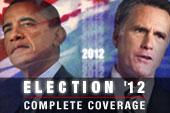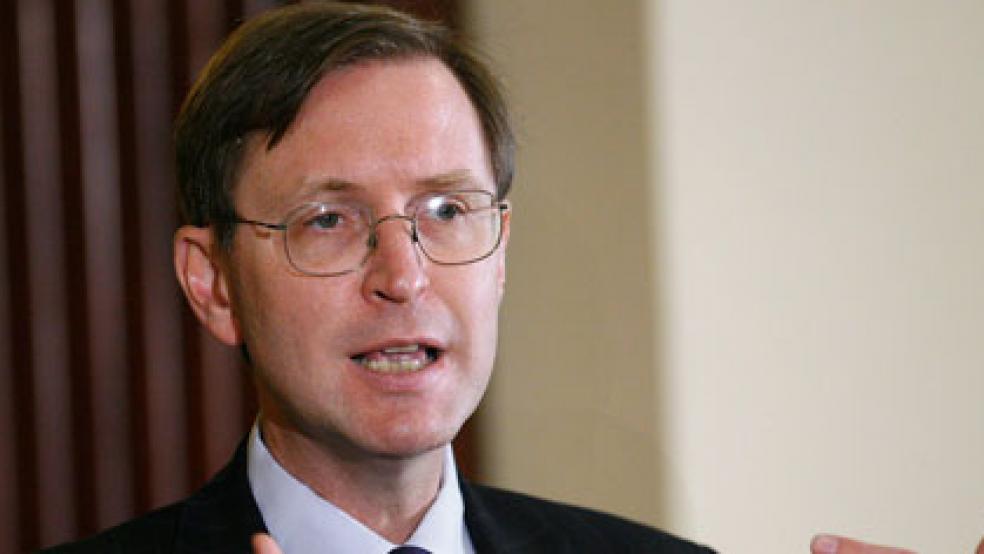As Mitt Romney’s prospects of winning the White House have greatly improved in recent weeks—with debate watchers favoring his stance on job creation—his top economic advisers are coming under increased scrutiny.

Until now, Glenn Hubbard, John Taylor and other economists who are the chief advocates of Romney’s policies have pretty much operated below the political radar. They’ve penned editorials, issued policy papers, and, occasionally, surfaced on television.
But over the past week, their analyses have been attacked as lightweight and misleading. And Hubbard—quite possibly the next Treasury Secretary or chairman of the Federal Reserve —has been singled out for his lucrative coziness with Wall Street.
When we elect a president, the country gets an entire presidency—hundreds of high-level staffers who influence the policies and priorities of an administration. President Obama has taken considerable heat for early projections by his own economics team that the 2009 stimulus would keep the unemployment rate below 8 percent, when in fact it peaked at 10 percent. The federal rescue of major banks, the deficit spending, and “shovel-ready” jobs pushed by his team have all drawn scorn from Republicans for the sluggish sub-2 percent economic growth that has followed.
Much of the intellectual backbone for that criticism came from the economists in Romney’s stable—who now face equally harsh microscopic examinations. If you get beyond the politics, these criticisms are important because they suggest this elite group has misdiagnosed the country’s financial woes and approved a mathematically impossible tax plan and budget.
The Romney campaign noted that this election is about the candidate, not his coterie that’s been attracting so much attention recently.
“Mitt Romney has assembled a diverse group of highly respected policy thinkers,” said campaign spokeswoman Andrea Saul. “He fields their opinions, evaluates them, and ultimately makes his own decisions on policy.”
If the former Massachusetts governor is elected, Hubbard is viewed by many as having the inside track to succeed Timothy Geithner as Treasury Secretary or Ben Bernanke as Fed chairman.
Hubbard, the dean of Columbia University’s Business School and former chairman of the Council of Economic Advisers for President George W. Bush from 2001 to 2003, developed Romney’s plan to create 12 million new private sector jobs in four years and served as a campaign mouthpiece in the editorial pages of The Wall Street Journal and on television. But detractors are quick to portray him as a high-priced hired gun for the financial community.
“He’s one of Gov. Romney’s most trusted friends and advisers and now that Gov. Romney is surging ahead, his opponents are attacking everyone associated with him,” Kevin Hassett, director of economic policy studies at the American Enterprise Institute and a Romney adviser who has worked with Hubbard, told The Fiscal Times Thursday. “That’s the normal circle of life in politics.”
As The New York Times noted in an extensive profile of Hubbard last weekend, the very smart and glib economist also brings a certain amount of baggage. He appeared briefly in “Inside Job,” http://www.businessinsider.com/glenn-hubbard-inside-job-2011-2 the Academy Award-winning 2010 documentary about the financial crisis. The highly critical film dealt in part with professors like Hubbard who endorsed many of the financial instruments that led to the 2008 financial meltdown and housing crisis.
Hubbard has been amply compensated for research and viewpoints that back up the positions of the corporate interests that are paying him, raising not just questions but in some instances, condemnation.
John P. Freeman, emeritus professor of business and professional ethics at the University of South Carolina School of Law, a long time critic of Hubbard’s scholarship as an academic for hire, says, “Dean Hubbard is a mercenary.”
“I formed a view of him that he works for money and essentially lends his name and reputation and credibility to very dubious intellectual and academic and scholarly endeavors – all for the purpose of essentially furthering the interests of the Wall Street establishment that he favors,” Freeman told The Fiscal Times yesterday.
The mutual fund industry, for example, has paid Hubbard more than $1 million over the years, according to The Times report. He took the position in an academic paper and a book that favored the industry’s approach to fees, which Freeman denounced as “price gouging” that hurt everyday investors.
The tight relationship with the mutual fund sector has overshadowed Hubbard’s equally controversial work for Fannie Mae, the government chartered housing mortgage giant that was placed into conservatorship in September 2008 after struggling with deep losses as the housing bubble popped.
After winding up his stint in the Bush White House, Hubbard produced an analysis for Fannie Mae in November 2003 arguing that the corporation’s balance sheet was sound and that it wasn’t suffering from the same underlying liquidity risk problems that plagued the commercial banking industry. His analysis came out as lawmakers weighed additional oversight of Fannie and Freddie Mac, but the reform bills never materialized. Hubbard concluded in his paper commissioned by Fannie Mae that there was no “compelling” argument that the semi-public corporation was vulnerable to a liquidity crisis that could spread throughout the entire mortgage market.
“Fannie Mae’s assets are more transparent, more easily priced and more marketable and actively traded than those of commercial banks,” Hubbard wrote. “In addition, Fannie Mae’s earnings have been less volatile than those of commercial banks over approximately the last decade as measured by Return of Assets and Net Interest Margin. These facts suggest that Fannie Mae’s overall asset risk is lower than that of other financial institutions.”
Less than five years later, the housing market collapsed and the government put a struggling Fannie and Freddie into conservatorship—a holding pattern that continues to this day at a combined cost to taxpayers of $188 billion, some of which has since been recouped in dividends.
“Hey, Glenn, Fannie Mae’s collapse cost the American taxpayers somewhere around $200 billion,” said a dubious Freeman, the University of South Carolina business ethics expert.“Would you still take that position today, professor Hubbard?”
Hubbard could not be reached for comment. However, Peter Navarro, a Democratic economics professor at the University of California-Irvine who co-authored a book with Hubbard, said in an interview, “A lot of people and pundits are in it for themselves, but I’ve never gotten that sense about Glenn.”
“He cares about the country,” Navarro said. “I’ve never seen him as opportunistic, but as someone who intelligently believes what he believes in.”
Hubbard and a slew of respected academic economists have endured challenges for their defense of Romney. They have authored harsh editorials critiquing Obama’s economic stewardship, while posting treatises in favor of Romney that some say could not pass peer review.
Their chief criticism of Obama’s economic policies—that the country should have bounced back much stronger from the recession—was attacked this week by Carmen Reinhart and Kenneth Rogoff, who as the authors the book, This Time is Different, studied 224 historical banking crises from around the world.
Republicans essentially argue that the 2008 meltdown is similar to the recession at the start of President Ronald Reagan’s first term, when unemployment hit 10.8 percent in 1982. Because the economic rebound was stronger under Reagan than Obama, they claim the president would have done more to aid the economy by permanently lowering tax rates.
“We are not really recovering from the recession, at least not compared to the period after previous big recessions such as the early 1980s,” Stanford University economist John Taylor wrote on his blog last January. In an editorial that same month for The Wall Street Journal, he explained Reagan’s recipe.
That entire diagnosis hinges on the 1982 recession being similar to the 2008 meltdown—and Reinhart and Rogoff say the more recent downturn was substantially worse than what Reagan grappled with. It was a “systemic financial” crisis, and the country fared rather well compared to the four other incidents when that occurred – in 1873, 1892, 1907, and 1929.
They note that the U.S. economy is not only performing better than average compared to other countries caught in the vortex of the meltdown. But they also stress in their white paper that Obama has done better compared to the average of the four previous systemic crises in the United States. "If one really wants to focus just on United States systemic financial crises, then the recent recovery looks positively brisk," they wrote in a recently published white paper.
Taylor responded Wednesday on his blog that the pair relied on a “narrower definition” of a financial crisis than he did, in addition to their decision not to “delineate between the ‘recession’ period and the ‘recovery’ period” in crises.
There is also the broader question of the “six studies” that Romney and his running mate, House Budget Committee Chairman Paul Ryan, cite as proof that they can slash income tax rates by 20 percent, get rid of the estate tax and alternative minimum tax, and reduce the budget deficit by curbing tax deductions in a way that doesn’t increase the tax burden on the middle class.
Josh Barro, a columnist for Bloomberg View, dissected the studies last week—noting, “four of them are blog posts or op-eds” as opposed to academic work. Working through each of them, he finds they fall short on revenues, depend on overly optimistic scenarios, or do raise taxes on Americans that Romney considers to be middle class.
In two other assessments by Harvard University professor Martin Feldstein, the middle class gets defined as someone earning more than $100,000 a year. Romney has identified Americans making less than $250,000 a year as middle class.
“I would note one item that the Romney campaign does not cite in support of its tax plan: Any analysis actually prepared for the campaign in preparation for announcing the plan in February,” Barro wrote. “You would expect that, in advance of announcing a tax plan, the campaign would commission an analysis to make sure that all of its planks can coexist.”





